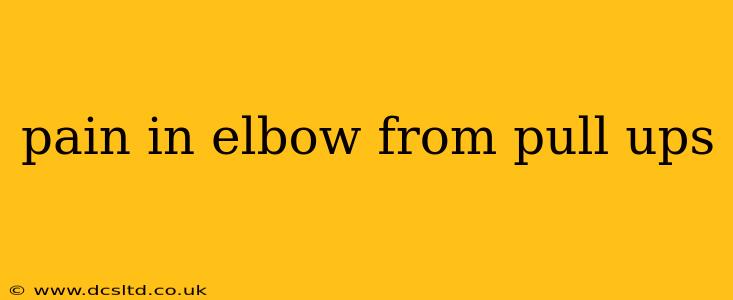Pull-ups are a fantastic exercise for building upper body strength, but they can also lead to elbow pain if not performed correctly. This comprehensive guide explores the common causes of elbow pain from pull-ups, effective prevention strategies, and various treatment options. Understanding the mechanics and addressing potential issues can help you continue your fitness journey without sacrificing your elbow health.
What Causes Elbow Pain After Pull-Ups?
Elbow pain after pull-ups is often related to overuse, improper form, or underlying medical conditions. Let's break down the most frequent culprits:
-
Golfer's Elbow (Medial Epicondylitis): This involves inflammation of the tendons on the inner elbow, often caused by repetitive gripping and flexing actions. In pull-ups, this can occur from excessive strain on the wrist flexors and forearm muscles.
-
Tennis Elbow (Lateral Epicondylitis): This affects the tendons on the outer elbow, typically from repetitive wrist extension. While less common with pull-ups than golfer's elbow, incorrect form or excessive weight can contribute to its development.
-
Ulnar Collateral Ligament (UCL) Injury: The UCL stabilizes the elbow joint. Overuse or forceful movements during pull-ups, particularly with improper technique, can strain or tear this ligament, leading to significant pain.
-
Muscle Strains: Overworking the forearm muscles (flexors and extensors) without adequate rest and recovery can result in strains, causing pain and discomfort in the elbow.
-
Bursitis: Inflammation of the bursae (fluid-filled sacs that cushion the elbow joint) can cause pain and swelling. Repetitive stress from pull-ups can irritate these bursae.
-
Poor Form: Incorrect pull-up technique, such as not engaging the back muscles properly or using excessive momentum, can place undue stress on the elbows and forearms.
How Can I Prevent Elbow Pain From Pull-Ups?
Prevention is key to avoiding elbow pain during and after pull-ups. Implementing these strategies can significantly reduce your risk:
-
Proper Form: Focus on using your back muscles to pull yourself up, avoiding jerky movements or relying solely on your arms. Maintain a controlled, slow ascent and descent.
-
Warm-up: Thoroughly warm up your muscles before any workout, including pull-ups. This includes dynamic stretches like arm circles and wrist rotations.
-
Progressive Overload: Gradually increase the number of pull-ups and weight (if using assisted pull-up machines) to avoid overstressing your muscles and tendons.
-
Rest and Recovery: Allow your muscles sufficient time to recover between workouts. Avoid performing pull-ups every day.
-
Strength Training: Strengthen your supporting muscles, particularly your back and forearm muscles, to distribute the load more evenly during pull-ups. Include exercises that target these muscle groups.
What Are the Treatment Options for Elbow Pain from Pull-Ups?
Treatment for elbow pain depends on the severity and cause of the injury. Options include:
-
Rest: Avoid activities that aggravate your elbow pain.
-
Ice: Apply ice packs to the affected area for 15-20 minutes at a time, several times a day, to reduce inflammation.
-
Over-the-Counter Pain Relief: Non-steroidal anti-inflammatory drugs (NSAIDs) like ibuprofen or naproxen can help manage pain and inflammation.
-
Physical Therapy: A physical therapist can guide you through specific exercises to strengthen your muscles, improve flexibility, and promote healing.
-
Corticosteroid Injections: In some cases, a doctor may recommend corticosteroid injections to reduce inflammation and pain.
-
Surgery: Surgery is usually considered only as a last resort for severe ligament injuries or when other treatments have failed.
Can I Still Do Pull-Ups if I Have Elbow Pain?
If you experience elbow pain during or after pull-ups, it's crucial to listen to your body. Stop the exercise immediately and consult a doctor or physical therapist. Attempting to push through the pain can worsen the injury. You might consider modifying your workout to include alternative exercises until the pain subsides.
How Long Does Elbow Pain from Pull-Ups Last?
The duration of elbow pain varies depending on the severity of the injury and the chosen treatment. Minor strains might heal within a few days or weeks with rest and ice, while more significant injuries may require several weeks or even months of treatment and rehabilitation.
What Exercises Can I Do Instead of Pull-Ups to Build Upper Body Strength?
Fortunately, there are many alternative exercises to build upper body strength without putting excessive stress on your elbows. These include rows (using dumbbells, barbells, or resistance bands), lat pulldowns, bicep curls, and triceps extensions. Consult with a fitness professional to create a suitable alternative workout plan.
By understanding the causes of elbow pain from pull-ups, employing preventative measures, and seeking appropriate treatment when needed, you can continue to enjoy the benefits of this powerful exercise while safeguarding your elbow health. Remember to always prioritize proper form, gradual progression, and adequate rest to minimize your risk of injury.
